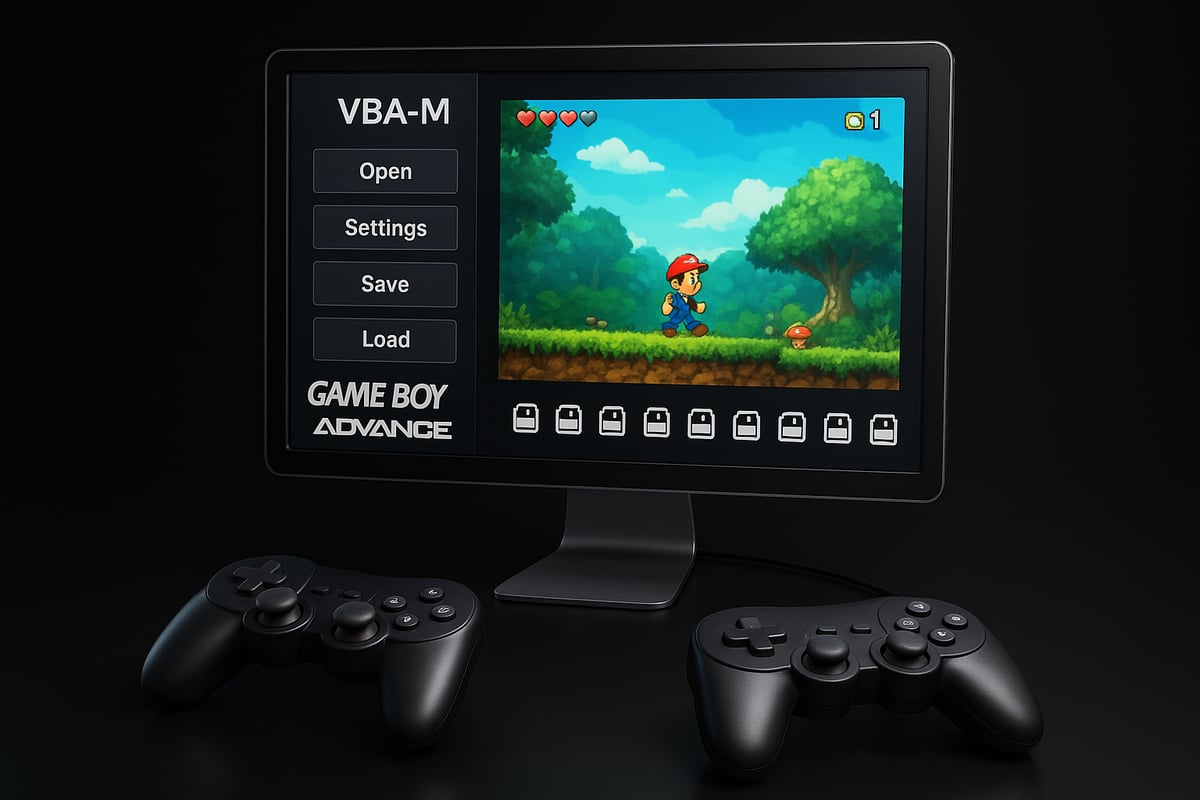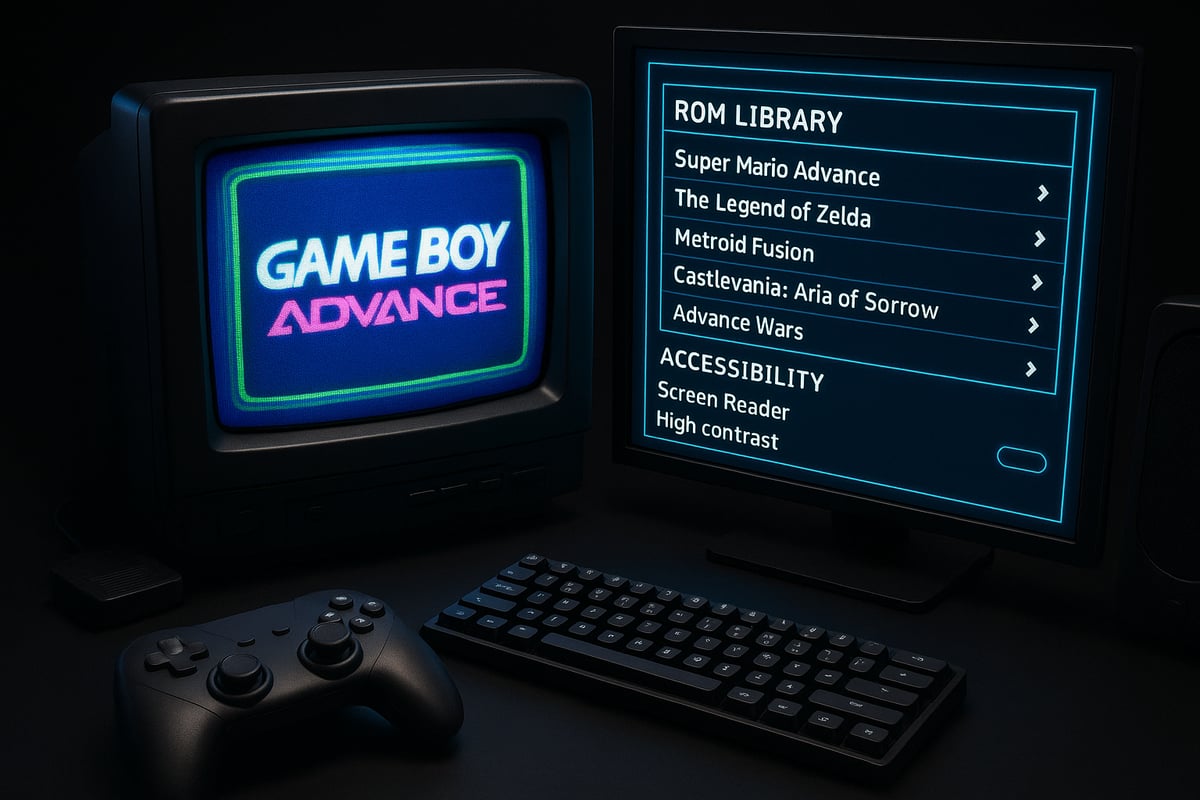Unlock the full potential of your retro gaming with vba -m, the top Game Boy Advance emulator for 2025. Whether you are a longtime fan or new to emulation, this guide walks you through every step for a seamless setup. Discover how to install, configure, and optimize your experience for authentic gameplay. We will explore new features, controller options, ROM management, and troubleshooting tips to help you enjoy flawless emulation. Ready to dive in? Let’s begin your journey to smooth and enjoyable classic gaming.
Understanding VBA-M: Features & Evolution
Unlocking the magic of retro gaming in 2025 starts with understanding what makes VBA-M unique. This section explores the evolution, standout features, and technical requirements of the vba -m emulator, helping you choose the right setup for your needs.
What is VBA-M?
VBA-M, or VisualBoyAdvance-M, is a multi-platform, open-source emulator designed for playing Game Boy Advance, Game Boy Color, and Game Boy games on modern computers. Building on the legacy of the original VisualBoyAdvance, vba -m combines improved accuracy with enhanced compatibility across Windows, macOS, and Linux.
Here’s a quick comparison of vba -m and other popular emulators:
| Emulator | Platforms | Supported Systems | Open Source | Community Support |
|---|---|---|---|---|
| VBA-M | Win, macOS, Linux | GBA, GBC, GB | Yes | Active |
| mGBA | Win, macOS, Linux | GBA, GBC, GB | Yes | Active |
| NO$GBA | Win | GBA, DS (partial) | No | Limited |
For a deeper look at the background and evolution of vba -m, visit the VBA-M Emulator Overview.
Key Features in 2025
The 2025 version of vba -m introduces significant enhancements that set it apart in the emulation space. Users benefit from advanced graphics rendering, including support for custom shaders and improved color accuracy. Enhanced audio emulation delivers lower latency and richer soundscapes, elevating the gaming experience.
Save state handling is more robust, with instant rewind features for quick retries. Modern controller compatibility, including hot-plugging, ensures seamless play. With vba -m, users enjoy an authentic retro experience powered by cutting-edge technology.
Why Choose VBA-M?
Choosing vba -m offers clear advantages. As an open-source project, it thrives on community-driven development and frequent updates, keeping it ahead of closed alternatives. The user interface is streamlined and customizable, making setup and navigation straightforward for beginners and experts alike.
Robust cheat code support enables players to unlock new possibilities in classic games. Extensive online documentation and a vibrant user community ensure that help is always available. With vba -m, you gain reliability, flexibility, and a supportive ecosystem.
System Requirements & Compatibility
To run vba -m smoothly in 2025, your system should meet these specifications:
- Operating System: Windows 11, macOS Ventura, or latest Linux distributions
- Processor: Dual-core CPU (minimum), Quad-core recommended for advanced features
- Graphics: Integrated GPU for basic use, dedicated GPU for HD shaders
- RAM: 2GB minimum, 4GB or more recommended
- Input Devices: USB or Bluetooth controllers, keyboard support
Vba -m is optimized for compatibility, ensuring stable performance across a wide range of hardware and peripherals.
Downloading and Installing VBA-M: Step-by-Step Setup
Unlocking the best retro gaming starts with a clean and reliable setup. Setting up vba -m correctly ensures you get the smoothest experience, no matter your system. Let’s walk through safe downloads, installation steps, and initial configuration to set the stage for flawless emulation.
Where to Download VBA-M Safely
The most important step before installing vba -m is downloading it from a trustworthy source. Always use the official VBA-M website or reputable repositories like GitHub. Unofficial sites may bundle malware or outdated files that compromise your system.
| Source | Trust Level | Notes |
|---|---|---|
| Official VBA-M site | Highly trusted | Latest stable builds |
| GitHub (VBA-M repo) | Highly trusted | Access to source & releases |
| Community forums | Varies | Check user feedback |
After downloading vba -m, verify the file’s integrity using checksums or digital signatures when provided. This extra step helps ensure your installation is secure and unmodified.
Installation Guide for Windows
Installing vba -m on Windows is designed for simplicity. Choose between the installer or portable zip version. Run the installer and follow the prompts, selecting your preferred directory—typically, a dedicated folder like C:\Emulators\VBA-M is recommended for easy management.
After extraction or installation, review the folder structure. Make sure you see the executable, docs, and subfolders for saves and screenshots. Launch vba -m for the first time, and confirm that it opens without errors. If prompted, allow the application through Windows Defender or your firewall.
Before you start gaming, double-check that you have administrator permissions for your chosen folder. This prevents issues saving configurations or progress, particularly when running vba -m as a standard user.
Installation Guide for macOS & Linux
Getting vba -m running on macOS or Linux involves a few more steps, but remains accessible to most users. For macOS, download the DMG or AppImage from the official source. Open the DMG and drag vba -m into your Applications folder. If you encounter a security warning, right-click and select “Open” to bypass gatekeeper.
Linux users can use pre-built AppImages or compile vba -m from source. For Ubuntu-based systems, try:
sudo apt install vba-m
Alternatively, follow the VBA-M Installation Guide for macOS for detailed, step-by-step help with macOS setup and troubleshooting.
After installation, launch vba -m and confirm the interface appears correctly. Address any missing dependencies or permissions as needed.
Initial Configuration and Language Settings
Once vba -m is installed, configure your preferred language and region for the interface. This helps make navigation and setup more intuitive. Open the settings menu and select your language from the available options.
Next, set default directories for your ROMs and save files. Navigate to the file paths section in settings, and choose locations that are easy to back up. Knowing where vba -m stores configurations and saves helps prevent data loss.
Having these settings in place ensures vba -m runs in your preferred environment and keeps your files organized from the start.
Updating VBA-M to the Latest Version
To keep vba -m performing at its best, regularly update to the latest release. Check for updates in the emulator’s “Help” or “About” menu, or visit the official website. Some builds include auto-update features, while others require manual downloads.
Before updating, always back up your settings and save files. Copy the Config and Saves folders to a safe location. Replace the old executable with the new one, then restore your backups if needed.
Staying up to date ensures vba -m remains secure, compatible with new games, and benefits from the latest performance improvements.
Configuring VBA-M for Optimal Performance
Fine-tuning your vba -m setup is essential for smooth, authentic emulation. With the right configuration, you can elevate both performance and visual quality, regardless of your hardware. This section will walk you through every key adjustment, ensuring your gameplay is seamless and enjoyable.
Video & Graphics Settings
Unlocking the best visuals in vba -m starts with selecting the ideal video backend for your system. Common choices include OpenGL for cross-platform support, Direct3D for Windows, or software rendering for compatibility. Adjust the resolution scaling to match your monitor, and choose an aspect ratio that preserves the original game's look.
Enable vsync to prevent screen tearing, and consider bilinear filtering for smoother graphics. Experiment with shaders for CRT or LCD effects, which can be found in the recent VBA-M 2.2.0 Release Notes for details on the latest enhancements. If you encounter graphical glitches, try switching video backends or toggling shader options within vba -m.
Audio Configuration
Sound plays a critical role in the vba -m experience. Start by setting your audio sample rate to match your hardware, typically 44100 Hz or 48000 Hz. Adjust the audio buffer size in the emulator settings to reduce latency and avoid crackling.
For best results, ensure audio synchronization with video is enabled, which keeps gameplay responsive. If you notice stuttering, decrease the sample rate or increase the buffer slightly. Regularly test your configuration by loading a game and listening for any artifacts, keeping vba -m’s audio emulation at its best.
Input and Controller Setup
Configuring input devices is straightforward in vba -m. Open the input settings and map your preferred keys or connect a modern controller such as Xbox, PlayStation, or Switch Pro. Most controllers are detected automatically, and hot-plugging is supported for convenience.
Set up custom hotkeys for quick actions like saving states or fast-forwarding. For multiplayer or link cable emulation, follow the emulator’s documentation to enable multi-player support. With vba -m, input latency is minimal when using wired controllers, making it ideal for competitive play.
Save States, Rewind, and Cheats
Mastering save management in vba -m can save you hours. Use the save state feature for instant snapshots of your progress. Assign hotkeys for quick saves and loads, and enable rewind functionality for instant retries if you make a mistake.
To activate cheats, enter them through the emulator’s cheat menu, and verify each code is compatible with your ROM version. If cheats do not work, double-check the code format and consult the vba -m user forums for troubleshooting tips. These features make vba -m a flexible platform for both casual and expert gamers.
BIOS and Firmware Files
For maximum compatibility, vba -m allows you to load a genuine Game Boy Advance BIOS file. This improves accuracy in certain games and enhances boot animations. Always obtain BIOS files legally, typically by dumping them from your own hardware.
Once acquired, set the BIOS path in the emulator’s configuration menu. Using the correct BIOS ensures vba -m runs games as intended, especially titles with unique hardware features. Keep your BIOS files organized in a dedicated folder for easy access.
Troubleshooting Common Setup Problems
If you experience crashes or freezes in vba -m, start by updating your graphics drivers and ensuring your emulator version is current. ROM loading errors may result from unsupported file formats or corrupted downloads. Try re-downloading your ROM or using a different image.
Performance drops can be caused by background applications or insufficient hardware. Lowering resolution or disabling resource-intensive features in vba -m can help. For persistent issues, consult emulator logs or seek advice from the active vba -m online community, where solutions are continually shared.
Advanced Features & Customization
Unlocking the advanced features of vba -m takes your emulation setup to the next level. Whether you want to recreate the classic CRT look, fine-tune your display, or streamline your ROM library, exploring these customization options can transform your experience.
Shader and Filter Customization
Personalizing the visual output of vba -m is easy with shader and filter support. You can emulate classic CRT scanlines, vintage LCD effects, or apply custom shaders for a unique aesthetic. For those seeking authenticity, community shader packs are widely available and simple to install.
To apply a shader, access the video settings, choose your preferred filter, and adjust parameters such as gamma or color palette. Experiment with built-in presets or download new ones from trusted sources. Shader customization in vba -m continues to evolve, with recent updates (see the VisualBoyAdvance-M Git Changelog) introducing enhanced compatibility and new visual effects.
These options give you the flexibility to match your display style to your favorite games.
Screen Layout & Display Options
vba -m provides multiple display configurations for every setup. You can switch between fullscreen and windowed mode with a single shortcut, allowing seamless transitions during gameplay. Multi-monitor support makes it possible to play on one screen while browsing your ROM library or guides on another.
Borderless window options keep your focus uninterrupted, while custom overlays and bezels add a retro arcade feel. Adjust the aspect ratio to preserve pixel accuracy or fill your screen for a more modern look. vba -m allows you to tailor the display to your preference, ensuring comfort and immersion.
Recording, Streaming, and Screenshots
Modern retro gaming is about sharing experiences, and vba -m includes built-in tools for capturing your best moments. Record video and audio directly within the emulator for easy playback or editing. Integration with OBS and other streaming software enables live broadcasts with minimal setup.
Use the screenshot feature to save crisp images or create animated GIFs for social media. All captures are stored in user-defined folders, keeping your content organized. These features make vba -m a powerful tool for content creators, speedrunners, and anyone who wants to showcase their gameplay.
ROM Management & Library Organization
A well-organized ROM library makes navigating your collection effortless. With vba -m, you can sort games into folders, apply naming conventions, and use playlists for quick access. The emulator scans your directories for new or duplicate files, keeping everything neat.
Favorites and playlists help you jump into your top games instantly. For large collections, search and filter functions save time. If you are interested in organizing your ROMs like a database, consider strategies similar to those used in spreadsheet applications. vba -m adapts to your library’s size and structure, making management straightforward.
Accessibility and Quality of Life Features
vba -m is designed for everyone, with a suite of accessibility options. Enable text scaling or high-contrast modes for easier visibility. Colorblind options adjust the palette for optimal clarity. Customizable hotkeys and autosave features provide added convenience.
Auto-pause prevents lost progress if you step away, while cloud integration ensures your saves are always backed up. These quality of life enhancements help make vba -m accessible and enjoyable for all users, regardless of their individual needs.
ROMs, Save Files, and Legal Considerations
Unlocking the full capabilities of vba -m means understanding how it handles ROMs, save files, and the legal landscape. Whether you are organizing your collection, backing up progress, or curious about emulator compatibility, mastering these essentials ensures a reliable and enjoyable retro gaming experience.
How to Load and Play ROMs
With vba -m, loading and playing ROMs is straightforward. Simply select your game file using the File menu or drag and drop it into the emulator window. Supported formats include .gba, .gbc, .gb, and zipped archives, making it easy to manage collections.
You can also batch load ROMs for faster access or use the quick switch feature to jump between titles. For those seeking to keep their library organized, consider using clear folder structures and consistent naming conventions. Adopting database techniques, similar to those described in Create an Excel database, can help streamline your ROM management and improve your vba -m experience.
Managing Save Files and Backups
Save file management is crucial when using vba -m. The emulator supports several types of save files:
| Save Type | Description |
|---|---|
| In-game saves | Native saves created by the original game |
| Emulator saves | Save states created instantly by vba -m |
| Battery saves | Persistent data, such as Pokémon progress |
To protect your progress, regularly back up both in-game and emulator save files. Store copies in separate folders or use cloud storage for added safety. This approach allows you to restore your game at any time, ensuring that your vba -m gameplay remains uninterrupted. Always verify save file locations in your settings to prevent accidental loss.
Importing/Exporting Saves and States
One strength of vba -m is its compatibility with other popular emulators. You can import save files from platforms like NO$GBA or mGBA, provided you convert them to the appropriate format. Exporting save states is also straightforward—just select the desired file and save location within the emulator.
If you encounter issues, double-check file extensions and make sure they match vba -m requirements. Troubleshooting save problems often involves renaming or converting files. This process ensures seamless transitions between devices, so your vba -m experience is always portable and reliable.
Legal and Ethical Use of ROMs
Understanding the legal considerations of using vba -m is essential. In 2025, copyright laws still apply to ROM files. You are permitted to use ROMs you have legally purchased or dumped from your own cartridges for personal use. Downloading copyrighted ROMs from unofficial sources poses legal and ethical risks.
Always check your local laws and respect intellectual property rights. If you wish to create backups, use official tools or your own hardware. By adhering to these guidelines, you ensure your vba -m usage remains compliant and respectful of game creators.
Expert Tips and Best Practices for Smooth Gameplay
Unlock the smoothest retro gaming possible with these actionable tips for vba -m. Whether you are running on a high-powered system or a modest laptop, these best practices ensure your emulation experience is seamless, visually stunning, and safe across all devices.
Performance Optimization for Low-End PCs
Maximize efficiency on older hardware by customizing vba -m settings. Reduce video resolution and disable shaders for a lighter load on your GPU. Choose the software rendering backend if your graphics card struggles with OpenGL or Direct3D. Lower the audio sample rate for smoother playback.
Consider these steps for optimal performance:
- Turn off vsync and unnecessary filters.
- Use frame skip to maintain consistent speed.
- Close background applications to free up system resources.
If you encounter persistent lag or crashes, you might find practical parallels with Excel troubleshooting tips, as both require systematic problem solving. Tweak settings until you achieve playable speeds with vba -m.
Enhancing Visuals and Audio Experience
For a visually rich experience, vba -m offers advanced options. Enable bilinear filtering and high-quality shaders to replicate classic CRT or LCD displays. Adjust aspect ratio to match your monitor, and scale resolution for sharpness on HD screens.
Customize audio by increasing the sample rate for cleaner sound. Sync audio and video to eliminate lag or stuttering. Experiment with audio buffer size to minimize delays. These refinements help you enjoy vba -m as close to original hardware as possible.
Multiplayer and Link Cable Emulation
Experience classic multiplayer titles by setting up vba -m’s link cable emulation. Configure local multiplayer by mapping controls for each player. For online play, use network tunneling features or supported plugins.
Supported games include popular Pokémon and Mario titles. Some limitations still exist, so check compatibility lists before starting. Troubleshooting multiplayer can involve adjusting latency or firewall settings, but with vba -m’s active community, solutions are often readily available.
Backup Strategies and Data Safety
Protect your progress in vba -m by establishing a backup routine. Automate save file backups to an external drive or cloud service. Regularly copy both in-game and emulator save states to prevent accidental loss.
For additional automation, explore tools or scripts inspired by broader business automation practices, similar to those found in Excel help for business automation. Cloud integration and autosave features further safeguard your data, ensuring vba -m remains a reliable choice for long-term play.
Staying Up-to-Date and Community Resources
Stay informed by checking vba -m’s official site and forums for updates and changelogs. Join Discord servers and participate in community discussions to share strategies and troubleshoot issues.
Leverage online guides, mods, and documentation to explore new features. The vba -m community is vibrant and supportive, making it easy to find help or inspiration for your retro gaming journey.







